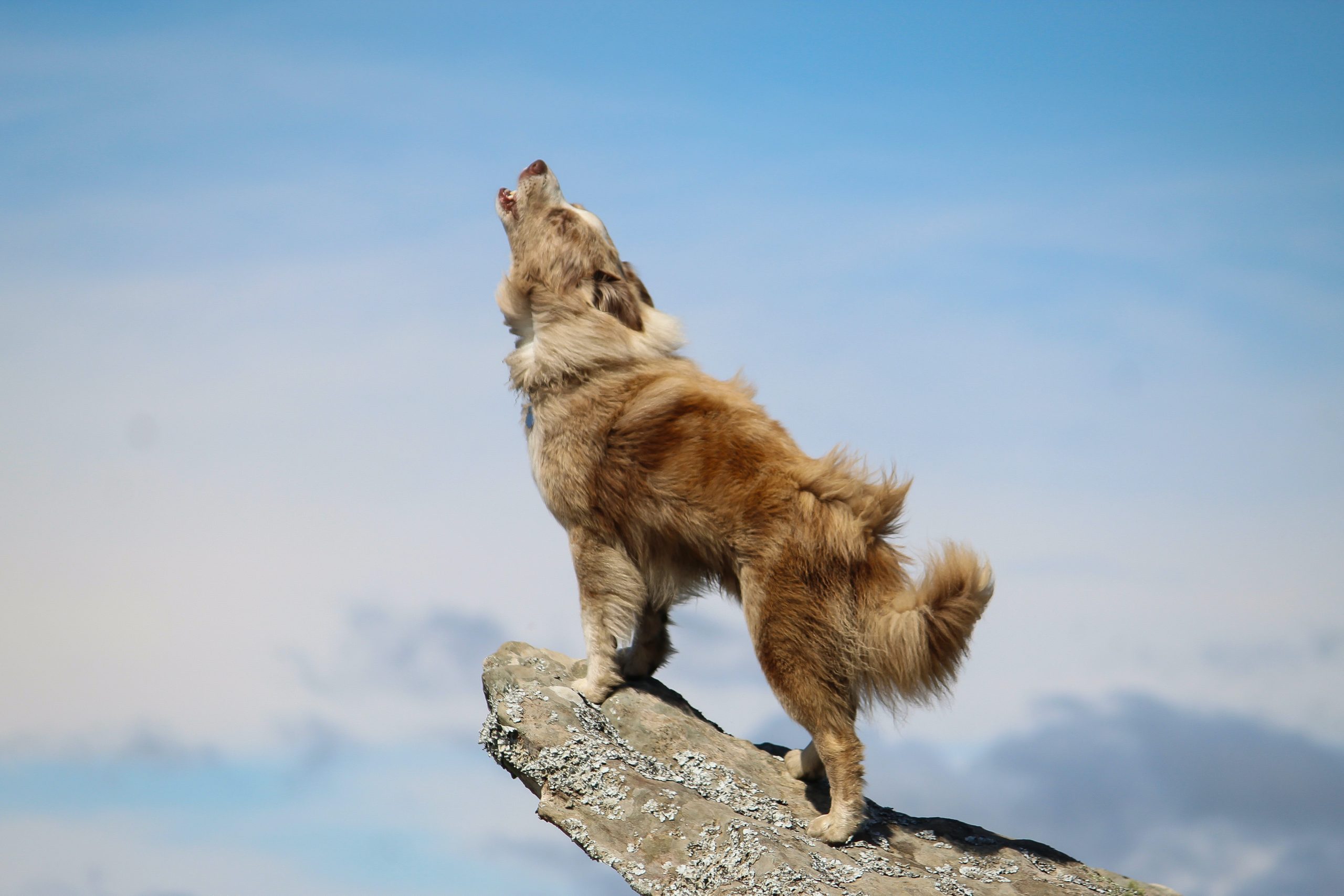Why Do Dogs Howl? The Science of Howling Behavior
Discover the evolutionary roots and communication purposes of dogs howling behavior, along with strategies for addressing excessive howling and understanding breed variations in vocalization.
Understanding the Evolutionary Roots of Dogs’ Howling Behavior
The evolutionary roots of dogs’ howling behavior can be traced back to their wolf ancestors, who used howling as a means of long-distance communication and territory maintenance [1]. This behavior is deeply ingrained in the social structure of wolves, serving as a vital tool for coordinating the movements of pack members and reinforcing their unity. For example, when a pack of wolves goes on a hunt, they may howl to communicate with each other, ensuring that they stay connected and work together effectively.
Furthermore, the deeply ingrained nature of howling in wolves has been passed down to domesticated dogs, highlighting the strong connection between the two. This suggests that dogs have inherited the instinctual need to howl as a means of communication, which has become a characteristic behavior across various breeds. This evolutionary link sheds light on the natural inclination of dogs to howl, as it is deeply rooted in their ancestry and serves as a fundamental form of expression and social interaction.
Communication Purposes and Triggers for Howling
Dogs’ howling behavior serves multiple communication purposes and is triggered by various stimuli. One of the primary reasons dogs howl is to get attention, whether it’s from their owners or other dogs in their vicinity. For instance, a dog may howl to summon their human family members back home or to communicate with distant dogs in the neighborhood, indicating their presence and possibly establishing territory boundaries. This highlights the social aspect of howling, as it can be a means for dogs to connect and interact with those around them.
Moreover, dogs use howling as a way to express their emotions and convey pain or discomfort. For instance, a dog may howl when experiencing separation anxiety, loneliness, or physical distress, signaling their emotional state to their owners or other dogs. This emotional aspect of howling emphasizes the depth of dogs’ communication abilities and their need to express themselves vocally in various situations.
In addition to internal emotional triggers, external stimuli like loud sirens or the howling of other dogs can prompt dogs to howl in response [2]. This behavior is often seen in ancient breeds of dogs, where howling can be a contagious behavior and a form of social signaling, resembling the way wolves communicate within their pack. This showcases the evolutionary link between modern dogs and their ancient wolf ancestors, shedding light on the deeply ingrained nature of howling as a means of communication and social interaction.
Addressing Excessive Howling in Dogs
When it comes to addressing excessive howling in dogs, it is crucial to identify the root cause. Excessive howling can be a sign of separation anxiety or underlying medical issues, so it’s important for pet owners to observe their dog’s behavior closely. For instance, if a dog exhibits signs of distress, restlessness, or destructive behavior when left alone, it could be indicative of separation anxiety. In such cases, making arrangements for the dog to feel safe and secure becomes paramount. This may include creating a comfortable and familiar space for the dog, using calming aids like pheromone diffusers, or seeking the assistance of a professional dog behaviorist to develop a tailored plan to address the anxiety.
Moreover, excessive howling in response to triggering noises, such as sirens or other dogs’ howling, can also be a cause for concern. In these instances, desensitization and counterconditioning techniques can be beneficial. For example, a gradual and controlled exposure to the triggering sound, paired with positive reinforcement in the form of treats or play, can help the dog form new, positive associations with the previously distressing noise. Over time, this can reduce the dog’s reactivity and diminish the excessive howling behavior.
By understanding the specific triggers and underlying issues leading to excessive howling in dogs, pet owners can implement targeted strategies to address the behavior effectively, ultimately improving the well-being of their canine companions. Check out our recent post about anxiety and how you can help your dog with this.
Breed Variations in Howling Behavior
The propensity for howling can indeed vary between different dog breeds, with ancient breeds such as the Siberian Husky, Alaskan Malamute, and Beagle being more inclined to vocalize or howl. These breeds have a strong genetic link to their wolf ancestors, which contributes to their heightened vocalization tendencies. For example, the Siberian Husky, originally bred by the Chukchi people of Siberia to pull sleds, has a rich history of howling as a means of communication, which has been preserved through generations.
However, it’s crucial to understand that a dog’s howling behavior is not solely determined by its breed. Individual traits and genetic factors also significantly influence a dog’s inclination to howl. For instance, while the Siberian Husky is known for its howling, not every Husky will exhibit this behavior to the same extent. Environmental factors, socialization, and the dog’s unique personality all contribute to its vocalization tendencies. This means that even within breeds known for howling, there can be significant variation in individual dogs’ expression of this behavior.
Exploring the Science Behind Dogs’ Howling Behavior
The evolutionary origins of dogs’ howling behavior can be traced back to the wolves, from which dogs have descended. Wolves howl to communicate over long distances and to maintain their pack’s territory. This form of long-distance communication and territory maintenance has been passed down to domesticated dogs, making howling a deeply ingrained behavior that serves as a means of communication and team-building among them. This connection to their wolf ancestors sheds light on the instinctual nature of howling in dogs and highlights its significance as a method of conveying messages, emotions, and social signals.
Furthermore, howling in dogs can also be linked to their need for attention, communication with people or other dogs, and expression of emotions. For example, when a dog howls in response to triggering noises, such as loud sirens or other dogs’ howling, it is a form of communication or a reaction to external stimuli [2]. This behavior is a testament to the multifaceted nature of howling in dogs and its role as a means of expression and social signaling. Understanding the science behind dogs’ howling behavior involves recognizing its evolutionary underpinnings and the various purposes it serves in their communication and interaction with their environment.
Concluding Thoughts on Dogs’ Howling Behavior
In conclusion, the science behind why dogs howl is a fascinating area of study that sheds light on the complex nature of canine behavior. Dogs’ howling behavior is deeply rooted in their evolutionary history, particularly in the communication and social structures of their wild ancestors, wolves. Understanding the evolutionary roots of dogs’ howling behavior provides valuable insights into the reasons behind this vocalization.
Moreover, it’s essential to recognize that excessive howling in dogs can be a symptom of underlying issues such as separation anxiety or medical problems. For instance, when left alone, dogs may howl as a response to feelings of loneliness and distress, which are indicative of separation anxiety. This highlights the importance of addressing not just the behavioral aspect of howling but also the emotional well-being of the dog. By identifying the root cause, owners can take appropriate steps to alleviate their dogs’ distress and prevent excessive howling.
Additionally, owners should also consider the unique traits and genetic factors of their dogs when assessing howling behavior. While certain breeds, especially ancient ones, may be more predisposed to howling, it’s crucial to recognize that each dog is an individual with its own distinct personality and tendencies. Therefore, understanding the interplay of breed predispositions and individual characteristics is vital in effectively addressing and managing howling behavior in dogs.


